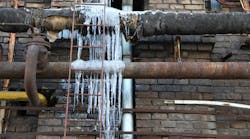Latest from Yates
Sponsored
Who comes up with the terms for weather events like “Bomb Cyclone”? As if there exists a single mechanical contractor who needed one more panic-stricken customer frantically seeking help. Some of the coldest record-breaking (day-after-day-after-day) temperatures in the past 100-years — pretty much anywhere in the continental United States of America.
As a Journeyman plumber in 1976, I spent a wintry Sunday evening on a date at a remote cabin in the woods along the bank of a frozen trout stream. We had walked the half-mile through a foot of snow due to the lane not being plowed. A roaring fire protected us from knowing the mercury was dropping like a stone and the walk back to my car was pure misery. The wind-chill was a record -50°F!
The next morning, my boss dropped me off to break up a sidewalk so we could excavate, expose the curb-valve, and install a new copper water service. An hour later, he returned, observed a small area of powdered concrete, and asked why the sidewalk was still intact. I handed him the 18-lb. sledgehammer. It didn’t take him long to realize this was an exercise in futility. We rented a tow-behind air compressor and for the next three weeks I installed new water services. The ground frost level had, by then, reached more than five-foot depth on the shady side of our city streets.
Then in ‘79, shortly after venturing out on my own, an overnight low well below 0°F lit up my phone. One of the first calls was in a row house with hot water standing cast iron radiators. The risers to the second-floor bay window radiator froze first, which stopped flow to the radiator, followed by the radiator starting to freeze. As the ice expanded within the piping and radiator, pressure continued to build until the weak link, a portion of the end section, decided to leave the room via a sidewall to their sewing room. Meanwhile, the rest of their hydronic system continued to work and was oblivious to the second-floor front room ice-bomb mayhem!
Now in 2017-2018: Frozen pipes, cracked boilers, heating equipment stressed beyond capacities for weeks without relief, people who have never had pipes freeze, and I’m talking folks well into their 80s, heat pumps that couldn’t heat with their electric resistance backup heat unable to maintain desired indoor air temps, and heating systems designed for “normal” ASHRAE design-day conditions (default in my Manual-J for where we live is a balmy 13°F) that could not provide desired indoor comfort settings.
Just days before the U.S. was gob-smacked with the December Polar Vortex, a customer’s cast iron hot water boiler was discovered to be leaking because she had received a surprisingly high water bill. Thinking a toilet must be running, she scheduled a service call and our tech heard water tricking into a floor drain near the boiler. Closer inspection revealed the end section was cracked. She elected to replace, rather than attempt a repair, for her 30-year-old boiler. Then the sudden cold-snap settled in and all hell broke loose for mechanical contractors everywhere.
She agreed to delay the installation and we assured her that if the leak became an emergency, we would move her to the top of the list (which was growing exponentially). Her call a few days later put up multiple red flags: it was only 59°F in her home and would not get any warmer. Granted, we were getting tons of calls regarding “My thermostat is set to 78°F, but it’s only 65°F. Do I need a new thermostat?”, but something was obviously wrong and had to be figured out before replacing her boiler. My guess was the leak had grown to a point where the boiler could not keep up or perhaps the aquastat was set lower than the normal 160°F/180°F range or that the heat load simply exceeded the boiler’s capacity. I’ve encountered more than a few of this manufacturer’s boilers with the aquastat getting out of calibration by 20°F, so I was expecting I might find it set for 160°F/180°F but maintaining 140°F/160°F.
Imagine my surprise to find the boiler’s burner off on limit with outgoing delivery temp at 180°F. After dropping to 160°F, the burner’s climb to 180°F was slow, but steady. All the convectors on the first floor (thermostat on an inside wall here) were hot and their air dampers wide open. Nothing blocking air-flow at the base openings. Windows and doors had been upgraded from single-pane to double-pane with urethane insulated weather-stripped doors. Two convectors on the second floor were air-bound with their air vents painted shut. First time they had heat in her son’s bedroom in years!
Checked the attic, which had R-19 insulation that was intact. Sloppily installed A/C with the air handler in the attic and all ceiling registers. Second-floor registers all exhibited streaking around their perimeters indicating they need to be sealed to stop air leakage and every room had ceiling lights, which is another air leakage issue. Bath fan exhausts into the attic, which is like leaving a window open a crack.
Back to the boiler and it was cruising along at 180°F. The only recourse was resetting the aquastat to 180°F/200°F to increase the Btu output of the convectors. The relief was knowing the boiler was not undersized. If anything, it is oversized, but just about at its limit for the existing bitter record-breaking cold weather. The heat emitters are only undersized at the moment due to air leakage created following a slap-dash central A/C installation. Once her home’s air leakage is addressed (and most homes lose around 40 percent of their thermal energy due to exfiltration), she won’t have any trouble maintaining indoor comfort.
Peeling back the fiberglass insulation around the ceiling registers and 4x4 boxes above the ceiling lights revealed airborne charcoal-black soot/dirt. If nothing else, fiberglass will reveal air leakage spots, as will thermal imaging, and several companies make relatively inexpensive infrared attachments for your smartphones. Check out www.thermal.com and www.flir.com/flirone/ios-android/.
Sometimes (actually more often than not) you have to look beyond the HVAC equipment to determine why your customers are experiencing comfort issues. In this case, at first glance it made no sense a home with upgraded windows and doors was stuck at 59°F when, according to the customer, had heated comfortably way back in ‘76 and ‘79 with leaky single-pane windows and poorly sealed doors.
Ideally, this customer should upgrade the building envelope before installing an On/Off boiler and also have a full-blown Manual-J heat loss done on a room-by-room basis that is then compared to each room’s convector(s) capacity at various water temperatures to determine just how hot the water has to be to match the room’s heat-loss on a design-day. I use an Excel spreadsheet to track each room’s performance and typically see a fairly pronounced difference. The poorest-performing room then dictates the outdoor reset curve and, with a modcon boiler that includes a boost feature to insure you can program a rise in water temperature above the design-day limit, you can rest assured you won’t get a 3:00 AM call complaining “your” boiler can’t keep up with my thermostat setting. It’s always “Your boiler, Your A/C, etc.” whenever something goes wrong, right?
Truth is she cannot afford to both replace her On/Off boiler and upgrade the envelope at the same time and, although she can obtain a zero-interest loan through a program we set up at our bank, she doesn’t qualify for the increased cost for a modcon. Between a rock and a hard place, we could resort to one of many consumer finance programs, but I cannot in good conscience offer finance company loans where our customers are charged credit-card interest rates where they end up paying for two or three boilers over time. We worked hard to set up zero-interest loans for our customers and while we pay an up-front fee, just like the bite the credit card companies take when our customers use credit cards to pay bills, but we get paid immediately and the customer then deals with the bank. It’s a win/win for all and it’s a great sales tool. It’s not like folks are sitting around thinking boy, we’d best be saving up the coin needed to replace the boiler/furnace/AC equipment that going to die at the worst possible moment. Zero interest? Are you freaking kidding me? Can we replace the A/C at the same time? Upselling effortlessly.
While we’re on the subject of upgrading the envelope or replacing the HVAC equipment, I landed in some hot water during a classroom setting over this issue. Seems like I was almost always in hot water during high school, so it was not to be avoided in my adult-ed class. Hope you enjoy a look back to this March 1, 2011, column, The Chicken or the Egg.
Dave Yates material both in print and online is protected by Copyright 2018. Any reuse of this material (print or electronic) must have the express written permission of Dave Yates and CONTRACTOR magazine. Please contact via email at [email protected].
Dave Yates
Dave Yates material in print and on Contractor’s Website is protected by Copyright 2017. Any reuse of this material (print or electronic) must first have the expressed written permission of Dave Yates and Contractor magazine.


